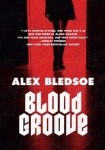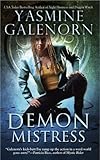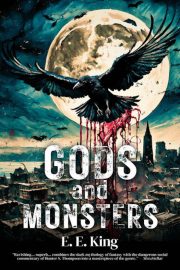Get Personal with your Marketing Efforts
In recent years, the topic of online marketing has become more of a focal point for several authors. Coupled with the changes in the publishing industry and advances in technology, I seem to have more discussions about online marketing than I do about writing fiction, in part because I’ve been involved in online marketing professionally for the past few years.
The words “online marketing” are fairly generic, since there are quite a few components involved with this business practice. Marketers (like myself) often utilize web analytics, social media, blogging, natural and paid search, online advertising, etc. For authors, online marketing may be a little more targeted to our writing and publishing efforts via social media and blogging platforms.
 Since online marketing is part and parcel to my career, I don’t think twice about leveraging my knowledge for my fiction efforts. Not every author has my experiences, though, which is why I turned to a few authors to find out what they thought. Alex Bledsoe, author of Blood Groove and The Sword-Edged Blonde, had this to say on the subject:
Since online marketing is part and parcel to my career, I don’t think twice about leveraging my knowledge for my fiction efforts. Not every author has my experiences, though, which is why I turned to a few authors to find out what they thought. Alex Bledsoe, author of Blood Groove and The Sword-Edged Blonde, had this to say on the subject:
“It used to be that a writer could simply write, and the publisher had a whole marketing structure there to take care of him or her. Back then it was feasible to be a recluse and still be a best-seller. It’s the romantic ideal of being a “writer.” Now, though, those structures are long gone, and the writer has to work in partnership with the publisher, or in some cases entirely on his or her own, to publicize books. The money simply isn’t there unless you’re on the level of a cottage-industry author. That said, there’s also unprecedented ways for authors to find readers and vice-versa.”
 Just like an online merchant targets their efforts to their customers, any author can focus their actions to attract, retain and reach their readers. Some authors, like Pat Rothfuss, author of The Name of the Wind, chose a more blended approach to attracting readers:
Just like an online merchant targets their efforts to their customers, any author can focus their actions to attract, retain and reach their readers. Some authors, like Pat Rothfuss, author of The Name of the Wind, chose a more blended approach to attracting readers:
“I maintain a blog, but I also really enjoy getting out and meeting people face-to-face at signings and conventions. It’s a real trade-off. The blog is more work, but it’s available to everyone with a computer. I make jokes, keep people informed about signings, and occasionally answer questions or give advice. Talking at a convention or a library is easier in many ways. You get to talk to people face-to-face and make a real connection. The audience is smaller, but connection is more personal, dynamic, and real.”
Pat’s approach works for him because, as he outlined in his quote, he feels comfortable making those face-to-face connections. Unfortunately, not every author may not have as much time to blog or go to conventions as Pat does, which means that their marketing efforts have to be structured differently. Does that mean that there’s “one way” to structure an online marketing plan? No, absolutely not. Often, the best online marketing plans are the most customized ones. For your work, that might mean you need to incorporate feedback from your agent or your publisher; another author might set up a content management plan (e.g. blogging schedule) to help them save time.
 Unfortunately, time is a factor for online marketing because creating content can be time-consuming. Is it worth it? Lilith Saintcrow, author of the new release Redemption Alley, had this to offer:
Unfortunately, time is a factor for online marketing because creating content can be time-consuming. Is it worth it? Lilith Saintcrow, author of the new release Redemption Alley, had this to offer:
“Fans want a personal relationship–that’s why they’re fans. A professional interactive presence online helps fans feel recognized and provides an emotional value to them, over and above the cost of a book. Fans are the people providing my paycheck; my professional online presence is a way for me to find out how well I’m earning that paycheck. It’s value added for the fans, and the best parts of a performance review for me, all rolled into one.
Developing a personal relationship with your readers does provide intrinsic value to them, because fans do enjoy connecting with the authors they admire. In online marketing, we cultivate that personal attachment through something called “personalization.” From creating personalized newsletters to writing about your editing process, personalization is about touching a reader in a place where they identify with you and subsequently, your work. By using personalization techniques, you’re fostering another form of advertising called “word-of-mouth.”
The easiest way to personalize your readers experience with your writing is to simply be online to engage your readers. The key to personalization is not “selling a book to an individual,” it means that you might field questions about your writing or talk about your hobbies or charities you support. It means, simply, that you’re both a professional author and someone interesting to talk to. How will you know when your efforts are successful? While there are multiple ways to track your actions, often the strangest things will start to occur. You’ll find yourself networking not only with readers, but with other authors and professionals, too.
 Another good example of how an author effectively uses personalization is Yasmine Galenorn author of the New York Times bestselling Otherworld series. Yasmine is very active on social media, but she also blogs and offers a newsletter for her fans, too.
Another good example of how an author effectively uses personalization is Yasmine Galenorn author of the New York Times bestselling Otherworld series. Yasmine is very active on social media, but she also blogs and offers a newsletter for her fans, too.
“I find that it’s important to establish a certain presence with readers, especially in today’s cyber-focused world. Because of the internet, authors have the ability to reach out to readers in ways like never before. However, there is a balance that must be reached. It can be dangerous to become over friendly with strangers who think they know you because of your books, and social networking can be time-consuming and tiring. But when kept in perspective, the net can also be a wonderful way to connect with readers and other writers. We can give our audience a glimpse behind the mask. While we ideally want our books to be the central focus—for writers of series, this can be an invaluable tool. Readers become heavily invested in our worlds. They want to know a little more about the person behind the cover, the creator of their favorite characters whom become beloved friends to them. And online networking can give them a hint of who we are.”
Yasmine is not alone in her experiences with her readers, for there is a challenge with becoming too accessible. Since the internet provides instant gratification with long-lasting effects, you’ll need to set up clear guidelines for yourself to manage your time and your communication. Regardless, if you do decide to engage your readers keep in mind that you’ll need to monitor the conversation. Unlike writing for a print medium, if you have a set-and-forget mentality for the internet, you may find yourself either completely removed from the conversation, or the subject of a delicate one.
Because the bulk of my published work has either been short fiction or game design, I’ve been able to experiment with the concept of personalization. One example of how I’m experimenting with different tools is my website for an urban fantasy novel called “Argentum.” Offering a portion of the first draft for a limited time, I’ve been able to connect with fans interested in watching the novel’s journey. Even though I’ve made mistakes, I’ve been honest and upfront about everything I’m doing, which has offered my readers an intimate look at the process of writing (and marketing) a novel online.
Just like my experiences with personalization might be a little different from the authors I listed above, yours will no doubt be different, too. Don’t be afraid to customize your marketing plan to your personality, because in the end “getting personal” means your readers will get to know “you.” What you want them to see is entirely up to you.
About the Author
Monica Valentinelli is the content and web analytics manager for the digital sheet music retailer http://www.musicnotes.com and the project manager for the horror and dark fantasy webzine www.flamesrising.com. In her spare time, Monica enjoys writing fiction, and has over a dozen game and fiction credits to her name including: “Pie,“ a short story found in the “Buried Tales of Pinebox, Texas,” her recent novella “Twin Designs” which was part of the collection Tales of the Seven Dogs Society, her flash fiction piece “Prey” on Pseudopod.org with more works on the way.
To read more about Monica, visit her urban fantasy novel located at www.violetwar.com or her blog located at www.mlvwrites.com.


